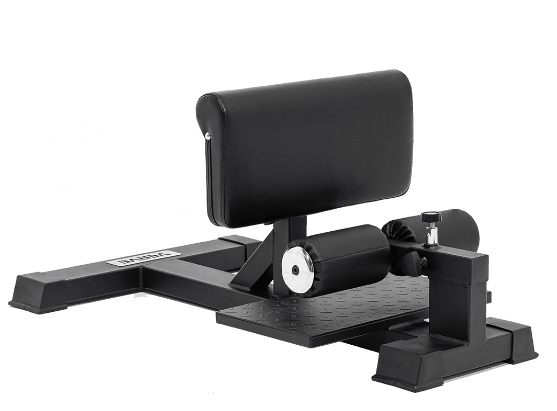Sissy squats are a challenging bodyweight exercise that can help build muscle in the quads and stabilize the knees. Although the name may suggest otherwise, sissy squats are far from an easy exercise. It requires a great deal of strength and balance to perform correctly.
Sissy Squat Key Takeaways
- Sissy squats are a bodyweight exercise that can help build muscle in the quads and stabilize the knees
- Sissy squats can be done without weights, making them an accessible exercise for anyone looking to build muscle
- Sissy squats can help improve flexibility and mobility in the knees, which is especially important for those who engage in activities that put a lot of strain on the knees
What is a Sissy Squat?
A sissy squat is a bodyweight exercise that targets the quadriceps muscles. The exercise involves leaning backward and bending from the knee to achieve the bottom of the position, rather than hinging from the hips and sitting down like in a traditional squat.
There are many different ways to do sissy squats as you will see below but the focus is always making it a quad-dominant exercise.
It is important to note that sissy squats can be challenging and may put undue stress on the knees if not done correctly. Therefore, it is important to maintain good form and start with a lower number of repetitions and sets.
Related Posts:
- Improve your ankle mobility with these 4 steps
- Hip Mobility: Exercises To Improve Your Range Of Motion
- Improve your Squat Mobility with these simple tips
How To Do A Sissy Squat Properly
To perform a sissy squat safely, be sure to complete an adequate warm-up including exercises that help warm up the area around the knee. Movements like reverse step ups and reverse sled drags will help prepare your knees and body for the movement.
Step 1: The Dip
Start by standing upright with your feet under your hips. Start by bending your knees and beginning to lean back slowly, while also bringing your heels off the ground. Use your arms to coutner balance against the lean backwards.
Step 2: The Lower
Continue to lower down in the same manner until you reach your limit, remember to not push into pain. If you’re new to the exercise, you can hold onto a door frame, TRX or a rack to help with your balance.
As you continue to lean back, lower your body towards the ground by bending your knees further. Focus on keeping your bodyweight on the balls of your feet and maintaining a straight line from your hips to your ankles.
FREE 6-Day Workout Routine!
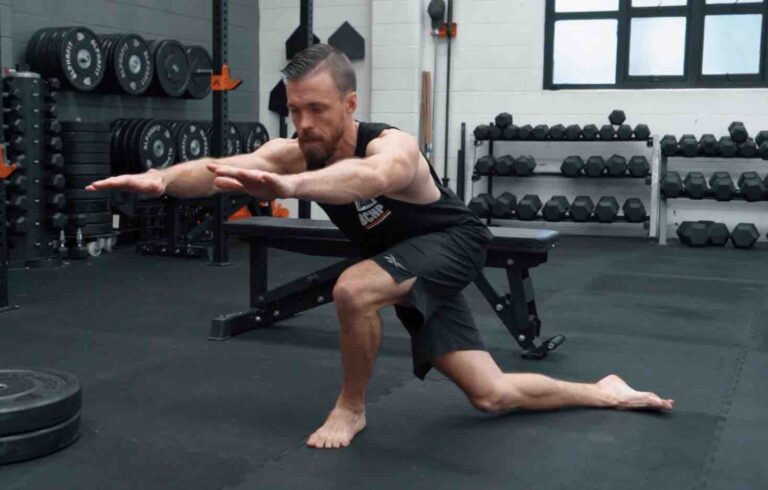
At home workouts, not equipment, for all-levels!
Sign up now for our FREE 6-day workout challenge and receive an exercise routine designed to help you start achieving your fitness goals.
Step 3: Return to Standing
As you lower your body, your torso will naturally lean backward slightly. Keep your core engaged to maintain a neutral spine. Pause briefly at the bottom of the movement, then push through your heels to return to the starting position.
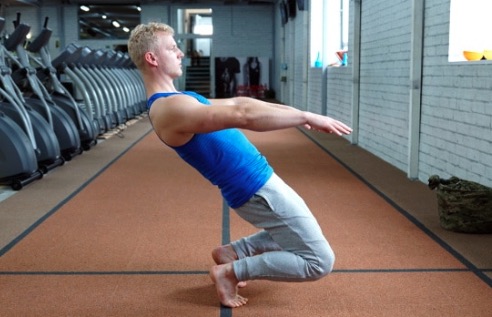
5 Sissy Squat Variations
Sissy squats are a great exercise to strengthen your quads and core without weights. However, adding some variations to your training routine can help you target different muscle groups and increase resistance. Here are a few sissy squat variations that you can try:
1. Assisted Sissy Squat
For beginners, the assisted sissy squat might be a great starting point. Using a door, TRX or something you can hold onto, lower yourself down into the movement slowly. Allow the item you’re holding onto to assist as much as you need to maintain perfect form.
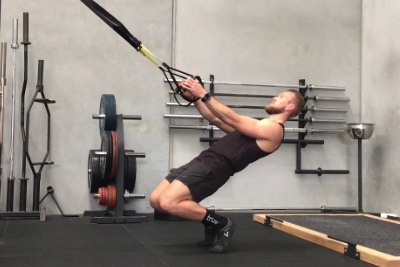
2. Heel Elevated Sissy Squat
This variation involves elevating your heels on a weight plate or a block. It increases the range of motion of the exercise and puts more emphasis on your quads. To perform the heel elevated sissy squat:
- Stand with your feet shoulder-width apart and place a weight plate or a block under your heels.
- Lower your body by bending your knees and leaning back.
- Keep your core engaged and your back straight.
- Lower your body until your thighs are parallel to the ground.
- Push yourself back up to the starting position.

3. Weighted Sissy Squat
Adding resistance to your sissy squats can help you build more muscle and strength. You can use dumbbells, a barbell, or a weighted vest to add resistance. To perform the weighted sissy squat:
- Hold the weights in front of your chest or on your shoulders.
- Lower your body by bending your knees and leaning back.
- Keep your core engaged and your back straight.
- Lower your body until your thighs are parallel to the ground.
- Push yourself back up to the starting position.
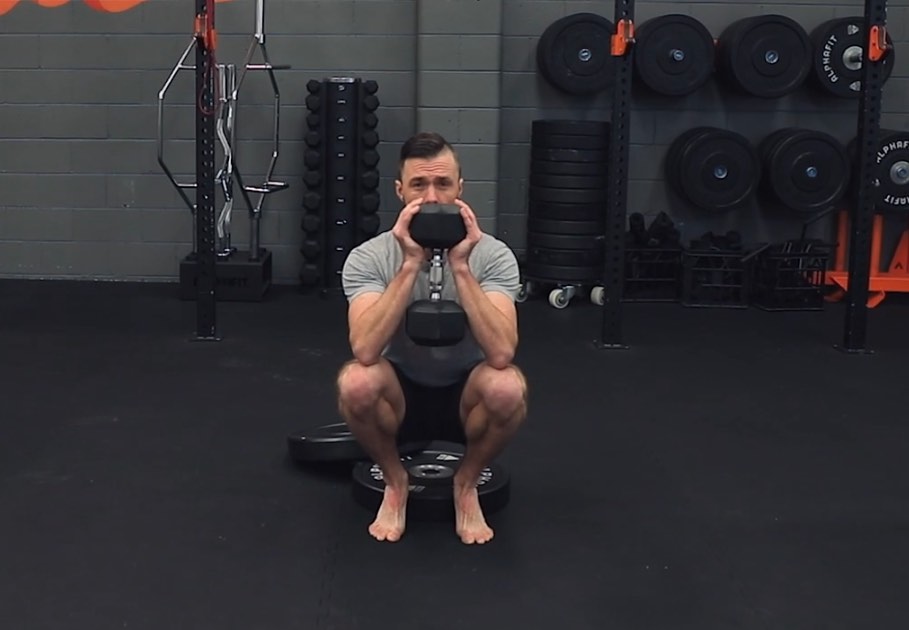
4. Narrow Stance Sissy Squat
This variation involves narrowing your stance to target your inner thighs and add more resistance. To perform the narrow stance sissy squat:
- Stand with your feet together.
- Lower your body by bending your knees and leaning back.
- Keep your core engaged and your back straight.
- Lower your body until your thighs are parallel to the ground.
- Push yourself back up to the starting position.
5. One-Legged Sissy Squat
This variation is more challenging and requires more balance and stability. To perform the one-legged sissy squat:
- Stand on one leg.
- Lower your body by bending your knee and leaning back.
- Keep your core engaged and your back straight.
- Lower your body until your thigh is parallel to the ground.
- Push yourself back up to the starting position.
Sissy Squat Equipment
Sissy squats can be done with or without equipment. However, using equipment can make the exercise more effective and easier to perform. Here are some of the equipment options available for sissy squats:
Slant Board
The slant board offers a great minimal equipment option for sissy squats. By using a single slant board or blocks under each heel, you can perform sissy squats at home, in the gym or on the road.
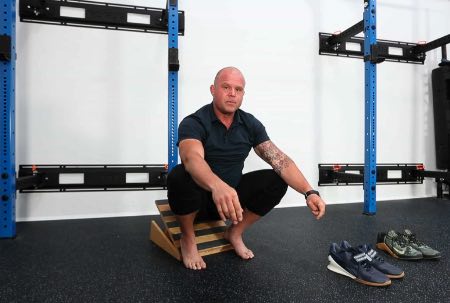
Related Articles:
Sissy Squat Machine
A sissy squat machine is a piece of equipment designed specifically for performing sissy squats. It provides resistance and support for the ankles, making the exercise more comfortable and effective. Sissy squat machines come in different sizes and designs, but they all work the same way. They have a padded knee rest and a footplate that holds the ankles in place. The user leans back and performs a squatting motion while keeping the upper body straight.
Barbell and Squat Rack
A barbell and squat rack can also be used for sissy squats. The user places the barbell on the squat rack and stands facing away from it. The barbell is then held behind the neck, and the user performs a squatting motion while keeping the upper body straight. This method requires more balance and coordination than using a sissy squat machine.
Resistance Band or TRX
A resistance band or TRX can be used to add resistance to sissy squats. The user wraps the band around a sturdy object, such as a pole or a squat rack, and holds it with both hands. The user performs a squatting motion while keeping the upper body straight. This method is more challenging than using a sissy squat machine for some but less challenging than using a barbell and squat rack.
Weight Plate or Dumbbell
A weight plate or dumbbell can be held against the chest to add resistance to sissy squats. The user holds the weight with both hands and performs a squatting motion while keeping the upper body straight. This method is less effective than using a sissy squat machine or a barbell and squat rack but can still provide a good workout.
Regardless of the equipment used, it is essential to perform sissy squats correctly to avoid injury. The exercise puts a lot of stress on the ankles and joints, so it is crucial to start with lighter resistance and gradually increase it over time. It is also essential to maintain proper form throughout the exercise, keeping the upper body straight and the knees aligned with the toes.
Benefits of Sissy Squats
After training thousands of people both online and in person i’ve found that one of the biggest benefits of sissy squats is that they can be done without weights, making them an accessible exercise for anyone looking to build muscle.
Here are some of the other benefits of including sissy squats in your workout routine:
Targets the Quads
Sissy squats place a significant amount of stress on the quads, making them an excellent exercise for building quad strength. The exercise is particularly effective at targeting the vastus medialis (VMO), the teardrop-shaped muscle on the lower, outer part of the quad.
Focuses on Knee Flexion and Extension
Sissy squats place a significant amount of stress on the knees, making them an excellent exercise for improving knee flexion and extension. This can help improve knee health and reduce the risk of injury if done with correct technique and the right amount of reps.
When returning from a knee injury, this movement can help strength muscles around the knee that may have atrophied during the time away from the gym or activity. Be sure to only progress to sissy squats after you have consulted and adequately qualified health professional and use equipment like a TRX to help unload the movement.
Safety and Precautions
When performing sissy squats, it is important to take safety precautions to prevent injury. Here are some safety tips to keep in mind:
Proper Form and Technique
Proper form and technique are crucial when performing sissy squats. It is important to keep the knees in line with the toes and maintain proper balance throughout the movement. Beginners should start with bodyweight squats and gradually progress to weighted squats to avoid injury.
Knee Health
Sissy squats can be a challenging exercise for the knees, and it is important to take care of them. Make sure to warm up before performing sissy squats and stretch afterwards to prevent knee pain. If you experience knee pain during or after sissy squats, it is best to stop the exercise and consult a physician.
Coordination and Balance
Sissy squats require coordination and balance, which can be challenging for some individuals. It is important to start with a stable surface and gradually progress to an unstable surface to improve balance and coordination. Using a chair or wall for support can also help individuals maintain balance while performing sissy squats.
Avoid Dangerous Movements
Avoid jerky movements and sudden changes in direction while performing sissy squats, as they can increase the risk of injury. It is important to perform the exercise in a slow and controlled manner to avoid any accidents.
Knee Flexion
Sissy squats require a high degree of knee flexion, which can be challenging for some individuals. It is important to start with a smaller range of motion and gradually progress to a full range of motion to avoid injury.
Sissy Squat – Frequently Asked Questions
What is the difference between a sissy squat and a regular squat?
The sissy squat is an isolation exercise that targets the quadriceps, while the regular squat is a compound exercise that works multiple muscle groups, including the quads, hamstrings, glutes, and lower back. The sissy squat is performed on the balls of the feet with the knees extending beyond the toes, while the regular squat is performed with the feet flat on the ground and the knees tracking over the toes.
Why is the exercise called a sissy squat?
The name ‘Sissy’ is a shortened nickname for King Sisyphus, who was sentenced to push a large rock up a hill only to have it roll back down, over and over for all eternity as a punishment from the Greek gods after cheating death not once, but twice!
What are the benefits of doing sissy squats?
Sissy squats can help build strength and muscle mass in the quadriceps, hip flexors, and core, while also improving knee stability and mobility. They are also a useful exercise for individuals who have trouble performing traditional squats due to knee pain or other limitations.
How can I progress in my sissy squat training?
To progress this movement, individuals can increase the number of repetitions, perform the exercise with added resistance, such as holding a weight plate, or try more challenging variations, such as the sissy squat jump or the sissy squat with a barbell.
Can sissy squats cause knee damage?
Like any exercise, sissy squats can cause knee damage if performed incorrectly or with too much weight. However, when performed with proper form and appropriate resistance, sissy squats can actually help improve knee health and stability.
Are weighted sissy squats effective for building muscle?
Yes, weighted sissy squats can be an effective exercise for building muscle mass in the quadriceps, particularly when performed with proper form and progressive overload. However, it is essential to start with lighter weights and gradually increase resistance to avoid injury.
